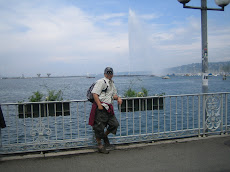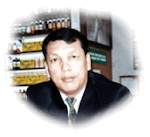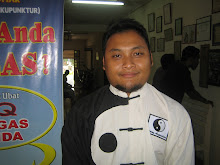Wednesday, September 8, 2010
Acupuncture For Stroke
Acupuncture in Stroke Treatment
by Russ Erickson, MD
Acupuncture therapy for stroke-caused conditions such as paralysis, speech and swallowing problems, and depression is commonly used in the Orient. In China and Japan, an acupuncturist is likely to start therapy as soon as possible after a stroke. However, my recommendation is a delay of 2 weeks before acupuncture for strokes caused by bleeding in the brain, 10 to 20% of strokes (instead of the usual blood vessel block or clot). The wait is due to studies showing that acupuncture opens blood vessels for better flow and decreases clotting and inflammation. These effects are desired early when arteries are blocked, but after a stroke caused by bleeding has occurred, it is safer to wait until the bleeding blood vessel has clotted and is unlikely to bleed further before providing the acupuncture.
Acupuncture is done on a daily basis in China. Uncertain as to whether daily acupuncture is essential, even in Western countries, some acupuncturists with experience in treating stroke with acupuncture believe treatment 3 times a week is optimal. Several different approaches have been used to treat stroke, demonstrating that acupuncture for this disorder remains a healthcare art: Traditional Chinese Yang meridian point therapy, Chinese scalp acupuncture,
Dr. Yamamoto's YNSA Japanese scalp therapy, Korean Koryo Chim hand acupuncture, supplemental ear (auricular) acupuncture, and Xingnao KaiQiao (a newer therapy by Professor Shi Xuemin) are each advocated by a number of treatment centers in Oriental countries. One need not know in depth the approach of each, but it is important to know that more than one approach is available and used.
Does acupuncture really work to help stroke victims improve? Many studies involving thousands of patients have been published in China and Japan, and 2 of 3 studies from Scandinavia, demonstrated significant help. These studies indicate that patients get well faster, perform better in self-care, require less nursing and rehabilitation therapy, and use less healthcare dollars. However, since most studies come from China, they get little credence from the Western medical community because researchers in China do not appear to be published unless their results are highly positive, so publication bias is possible. And, no money has been made available in the United States for studies needed to confirm the claims of experts in China and Japan of indeed helping stroke patients. Such studies, if done well, demand significant funding; sources of such money are difficult to find. Most physicians, including rehabilitation experts, have appeared unwilling to consider acupuncture therapy, not due to bias but because the published studies do not necessarily meet research study criteria for the United States.
Acupuncture is a safe therapy, and my experience has taught that this is especially true when helping stroke victims. Even discomfort is generally minimal. If one compares the possible positive help to be obtained with the risks associated with acupuncture, my contention is that acupuncture is worthy to attempt for stroke therapy. Studies are needed in the United States to prove this to medical skeptics. It will be important for such studies to involve skilled acupuncturists with experience in stroke therapy.
Adding acupuncture to rehabilitation therapy obviously increases the cost; daily-to-3 times-weekly treatment is needed for 2-4 weeks or longer. Concern for added cost would perhaps disappear if the end result demonstrates more self-care and less dependence on family and health providers.
Bahasa Melayu:
Untuk rawatan strok, perubatan biasa tidak ada banyak pilihan rawatan, melainkan menjalani terapi baik pulih anggota Ubat khas strok tidak ada, biasanya doktor akan melihat tekanan darah, sekiranya strok disebabkan oleh tekanan darah tinggi, maka doktor akan bagi ubat untuk menurunkan tekanan darah tinggi dan bika ubatan khusus untuk strok.
Cara yang terbaik untuk merawat strok ialah, makan ubat dan dalam masa yang sama menjalani rawatan dengan cara akupunktur.
Jika strok yang baru, anda perlu menjalani rawatan akupunktur kurang lebih 10 hingga 15 kali sahaja.
Bacaan lanjut dan foto-foto rawatan boleh dilihat dalam laman
http://homeopathymalaysia.org.my
by Russ Erickson, MD
Acupuncture therapy for stroke-caused conditions such as paralysis, speech and swallowing problems, and depression is commonly used in the Orient. In China and Japan, an acupuncturist is likely to start therapy as soon as possible after a stroke. However, my recommendation is a delay of 2 weeks before acupuncture for strokes caused by bleeding in the brain, 10 to 20% of strokes (instead of the usual blood vessel block or clot). The wait is due to studies showing that acupuncture opens blood vessels for better flow and decreases clotting and inflammation. These effects are desired early when arteries are blocked, but after a stroke caused by bleeding has occurred, it is safer to wait until the bleeding blood vessel has clotted and is unlikely to bleed further before providing the acupuncture.
Acupuncture is done on a daily basis in China. Uncertain as to whether daily acupuncture is essential, even in Western countries, some acupuncturists with experience in treating stroke with acupuncture believe treatment 3 times a week is optimal. Several different approaches have been used to treat stroke, demonstrating that acupuncture for this disorder remains a healthcare art: Traditional Chinese Yang meridian point therapy, Chinese scalp acupuncture,
Dr. Yamamoto's YNSA Japanese scalp therapy, Korean Koryo Chim hand acupuncture, supplemental ear (auricular) acupuncture, and Xingnao KaiQiao (a newer therapy by Professor Shi Xuemin) are each advocated by a number of treatment centers in Oriental countries. One need not know in depth the approach of each, but it is important to know that more than one approach is available and used.
Does acupuncture really work to help stroke victims improve? Many studies involving thousands of patients have been published in China and Japan, and 2 of 3 studies from Scandinavia, demonstrated significant help. These studies indicate that patients get well faster, perform better in self-care, require less nursing and rehabilitation therapy, and use less healthcare dollars. However, since most studies come from China, they get little credence from the Western medical community because researchers in China do not appear to be published unless their results are highly positive, so publication bias is possible. And, no money has been made available in the United States for studies needed to confirm the claims of experts in China and Japan of indeed helping stroke patients. Such studies, if done well, demand significant funding; sources of such money are difficult to find. Most physicians, including rehabilitation experts, have appeared unwilling to consider acupuncture therapy, not due to bias but because the published studies do not necessarily meet research study criteria for the United States.
Acupuncture is a safe therapy, and my experience has taught that this is especially true when helping stroke victims. Even discomfort is generally minimal. If one compares the possible positive help to be obtained with the risks associated with acupuncture, my contention is that acupuncture is worthy to attempt for stroke therapy. Studies are needed in the United States to prove this to medical skeptics. It will be important for such studies to involve skilled acupuncturists with experience in stroke therapy.
Adding acupuncture to rehabilitation therapy obviously increases the cost; daily-to-3 times-weekly treatment is needed for 2-4 weeks or longer. Concern for added cost would perhaps disappear if the end result demonstrates more self-care and less dependence on family and health providers.
Bahasa Melayu:
Untuk rawatan strok, perubatan biasa tidak ada banyak pilihan rawatan, melainkan menjalani terapi baik pulih anggota Ubat khas strok tidak ada, biasanya doktor akan melihat tekanan darah, sekiranya strok disebabkan oleh tekanan darah tinggi, maka doktor akan bagi ubat untuk menurunkan tekanan darah tinggi dan bika ubatan khusus untuk strok.
Cara yang terbaik untuk merawat strok ialah, makan ubat dan dalam masa yang sama menjalani rawatan dengan cara akupunktur.
Jika strok yang baru, anda perlu menjalani rawatan akupunktur kurang lebih 10 hingga 15 kali sahaja.
Bacaan lanjut dan foto-foto rawatan boleh dilihat dalam laman
http://homeopathymalaysia.org.my
Subscribe to:
Post Comments (Atom)

























No comments:
Post a Comment